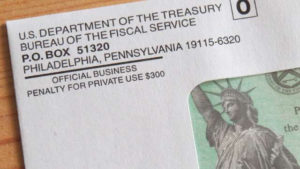 It’s official: the second round of stimulus payments are on their way out to millions of Americans, with the first transfers hitting the wires on the night of Dec. 29. Some Americans may already be seeing payments in their bank accounts, a much-needed lifeline at a time when many are feeling a heavy financial strain brought on by the pandemic. But if you’ve never received a direct deposit from the IRS before, you may be waiting until at least early January to see your stimulus check arrive in the mail, CNBC reports. Read on to see why you may be weeks out from payment, and for more on the current pandemic, check out The CDC Just Issued This Warning About the New COVID Strain.
It’s official: the second round of stimulus payments are on their way out to millions of Americans, with the first transfers hitting the wires on the night of Dec. 29. Some Americans may already be seeing payments in their bank accounts, a much-needed lifeline at a time when many are feeling a heavy financial strain brought on by the pandemic. But if you’ve never received a direct deposit from the IRS before, you may be waiting until at least early January to see your stimulus check arrive in the mail, CNBC reports. Read on to see why you may be weeks out from payment, and for more on the current pandemic, check out The CDC Just Issued This Warning About the New COVID Strain.
In a set of tweets posted on Dec. 29, Treasury Secretary Steve Mnuchin announced that payments “may begin to arrive in some accounts by direct deposit as early as tonight,” with the IRS later confirming that such transfers would be continuing through the following week, according to CNBC. But those who’ve never set up direct deposit with the IRS to receive a tax refund will likely be waiting through the first weeks of 2021 for a paper check or debit card to arrive in their mailbox. Checks are scheduled to begin being mailed out as early as Dec. 30.
If you’re not sure which form to expect, it’s most likely safe to assume that you’ll be getting the same type of payment that you received during the first round of stimulus checks in the spring. And even those with direct deposits set up may not be on the fast track: the IRS warned that some people “may see the direct deposit payments as pending or as provisional payments in their accounts before the official payment date of January 4, 2021.”
“Throughout this challenging year, the IRS has worked around the clock to provide Economic Impact Payments and critical taxpayer services to the American people,” IRS Commissioner Chuck Rettig said in a statement. “We are working swiftly to distribute this second round of payments as quickly as possible.”
Still have questions about your incoming stimulus payment? Read on to find out what you can expect, and for more on the current state of things, check out This Is How Bad the COVID Outbreak Is in Your State.
